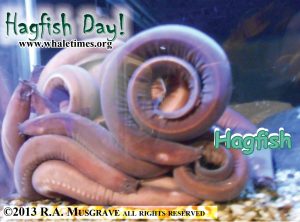Good News! We had a chance to talk to Dr. Andrew J. Clark, Associate Professor of Biology at College of Charleston, before he began his Hagfish Day festivities. Dr. Clark has been studying hagfish for many years, so we suspect Hagfish Day is a humongous deal in his lab. We wondered if he and his team decorated with hagfish garland, had a hagfish piñata, or maybe had a Secret Hagfish gift exchange…but we were so interested in his research we forgot to ask! Meet Dr. Clark.
Dr. Clark, how long have you been studying hagfish? Do you study them from a ship or in a lab?
- AC: About 15 years. Most of time my colleagues at the lab and I study them in the lab.
What was your first thought when you heard that hagfish finally got their own holiday?
 AC: I’ll admit, it also made me feel as if I was finally studying the cool ocean animal! I studied hagfish as a grad student while other students studied more popular animals like dolphins, sharks, stingrays, and sea turtles.
AC: I’ll admit, it also made me feel as if I was finally studying the cool ocean animal! I studied hagfish as a grad student while other students studied more popular animals like dolphins, sharks, stingrays, and sea turtles.
If you’re going to create a holiday, hagfish will turn a lot of heads! Like the underdog around the popular ocean kids (aka dolphins and sea otters) hagfish don’t look like much. That is until you see them doing things other animals cannot.
It’s also a cool that a Hagfish Day introduces ocean animals that may not seem as cool at first, but are as fascinating as they are ecologically important.
What do you study?
- AC: Over the past few years, my colleagues and I have been studying how hagfish bite and the structural and material properties of their skins.
Hagfish bite? I thought they didn’t have a real set of jaws like, say a shark or people.
- AC: Hagfish bite hard even though they do not have upper jaws. Sort of like lower jaws, hagfish have “tooth plates” that can be forcefully driven into food. To bite really hard, a hagfish must use its entire body like an upper jaw to counteract the biting action of the lower jaw or tooth plates. It will either swim into the prey while biting or tie itself into a knot. While tying its tail end into a knot, the hagfish grabs the food with its tooth plates, and then while it retracting its teeth, the knotted part of body rolls over the head and pushes against the food as the teeth are pulling back. At this moment, the knotted body becomes a rigid ball (or an upper jaw) that counter balances the lower jaw-like actions of the tooth plates.
- VIDEO: Watch a hagfish bite
- VIDEO: Biting Atlantic Hagfish
Why study hagfish skin?
- Hagfish have odd skin. It is unusually baggy. A hagfish needs to be able to twist its body — twist it in ways that most fish cannot. We want to know about the structural and material characteristics of their skin that allows them to do this.
A typical fish, like a salmon or tuna, has tightly wrapped skin. Tight skin has important functions. For example, it reduces drag. Think of an Olympic swimmer who wears tight fitting bathing suit and a hair cap to help him or her swim faster. A fish’s tight skin also helps it retain an optimal body shape for swimming. The skin also helps fish keep their body from overbending which could hurt vertebral column.
In contrast, hagfish have baggy skin. Very draggy for steady swimming but very handy for maneuvering and avoiding shark bites. Sort of like a karate uniform (gi) that allows the athlete to kick, turn, or twist without limiting her or his movement. Also, the loose fit of the gi makes it really difficult to grab the person underneath the gi.
Read more about it: Clark, A.J., Crawford, C.H., King, B.D., Demas, A.M. and Uyeno, T.A., 2016. Material properties of hagfish skin, with insights into knotting behaviors. The Biological Bulletin, 230(3), pp.243-256.
Is it true some hagfish can tie themselves into fancy knots? Can they tie themselves into bows?
- AC: Hagfish are the world’s best contortionists. A hagfish can tie and untie itself like we tie and untie a rope. Atlantic hagfish are limited to simple overhand knots. Pacific hagfish are more acrobatic. Pacific hagfish can tie themselves into overhand knots, figure 8s, and even more complicated knots. They can even form two knots at once!
How can I help hagfish?
- AC: Helping hagfish starts with awareness. Hagfish eat carrion or carcasses that fall to ocean floor. They are the clean up crew, the garbage collectors of the deep. That makes them an important part of the food web.
Do you have a special shirt made of hagfish slime to wear on Hagfish Day?
- No not now, but I can’t wait until Dr. Fudge can make one for me! (also see: Save the Planet, Wear Hagfish Slime)
Thank you Dr. Clark for joining us for Hagfish Day. Be sure to follow his very cool research.
